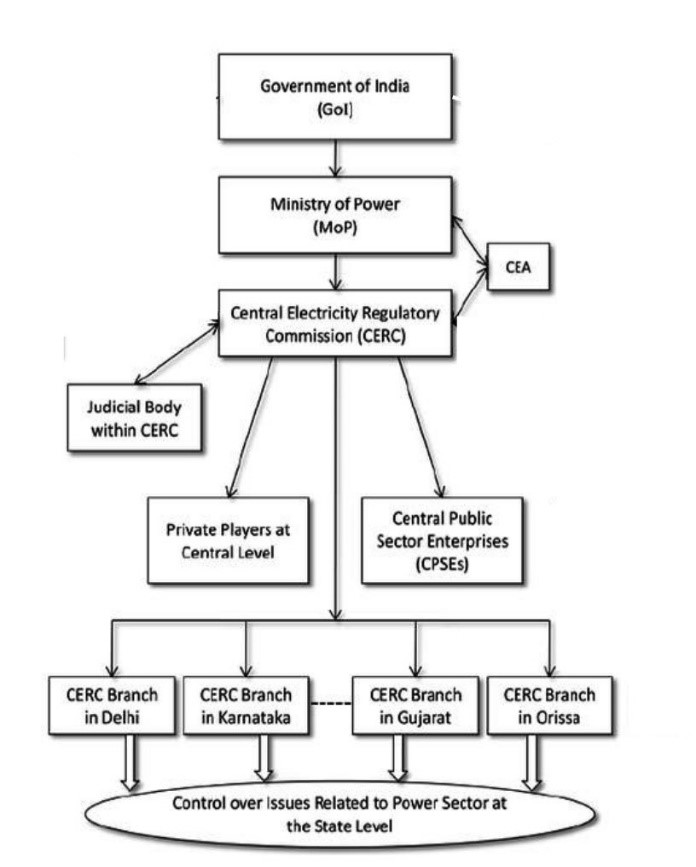Introduction
In the Indian Constitution, electricity is listed under the concurrent list. Both the Union Parliament and the State Legislatures (State) in India have the authority to adopt laws relating to electricity due to the supremacy of laws passed by the Union Parliament.
The Ministry of Power has been putting a significant amount of effort into creating a unified national grid, strengthening the distribution network, and achieving universal household electrification over the past few years to transform the nation from one with a power shortage to one with a surplus. For the efficient utilization of non-conventional energy, the Government of India has also formed a separate department known as the Ministry of New and Renewable Energy. The coal, oil and solid biomass together supply over 80%of India’s energy demands. India is fourth in the world in terms of installed capacity for renewable energy (including large hydro), wind power, and solar power (as per REN21 Renewables 2022 Global Status Report). By 2030, the Ministry of Power intends to have 500 GW of installed non-fossil electrical capacity. As of October 31, 2022, 172.72 GW of capacity derived from non-fossil fuel sources have been built nationwide. This comprises 119.09 GW of renewable energy, 46.85 GW of large hydropower, and 6.78 GW of nuclear power. As of October 31, 2022, this accounted for 42.26% of the nation’s total installed generation capacity, or 408.71 GW.
Background:
Since India’s independence, the electricity industry has made considerable advancements. India had a 1,362 MW capacity for electricity production at the time of its independence in 1947. Private utility firms dominated the production and distribution of electrical electricity. India has one of the most diverse electrical industries in the world. Coal, lignite, natural gas, oil, and nuclear power are among the traditional energy sources used to create electricity. Other dependable non-conventional energy sources include wind, sun, hydropower, agricultural waste, and domestic waste.
Sources of Energy:
One of the most crucial elements of the economic infrastructure is energy. It is the fundamental element required to maintain economic growth. There are two major sources of energy:
- Conventional Sources
These energy sources are also known as non-renewable sources. All of these sources, except hydropower, are scarce. They may further be classified into commercial (e.g., Coal, petroleum, electricity) and Non-Commercial energy sources (e.g., Firewood, straw, dried dung). The growth of industrial sector and the production of electricity have both been fuelled by coal, which continues to make up the majority of the energy mix. - Non-Conventional Sources
These are also referred to as renewable energy sources. India is blessed with an abundance of sunlight, water, wind and biomass. The most extensive programmes for the development of these renewable energy sources are in India. The nation has grown more reliant on fossil fuels including coal, oil, and gas as a result of rising energy use. Increasing energy costs and the possibility of shortages have increased concerns about the security of the nation’s energy supply, which has had a negative impact on the expansion of the national economy.
- Solar Energy: By enclosing the solar cells within the panels, the solar energy from the sun is used to produce electricity. It is utilized for heating, lighting, and other purposes.
- Wind Energy has been utilized to produce electricity by harnessing the force of the wind through turbines connected to power generators. These wind farms are typically found close to high-wind regions like mountains or the seaside.
- Nuclear Power Plants: Atomic nuclei found naturally in radioactive sources including uranium, thorium, and others are used to generate nuclear energy. Power is produced when nuclear fuels are processed in nuclear reactors.
- Geothermal Energy: is the heat that the earth provides. Hot springs are a common source of geothermal energy in many places. Power has been produced by using the earth’s internal heat.
- Tidal Energy: Tidal waves can also be used to generate electricity by building dams. Near the end of tides, when the turbines help to capture the energy, the thin dams are constructed.

Regulatory Structure:
The Ministry of Power is in charge of managing maintenance initiatives, transmission, generation, and supply of energy, as well as infrastructure development. While the CEA, a statutory agency established by the Electricity Act, provides the Government of India with advice on the development of policies, safety regulations, and technical standards.
As a guide for the Central Electricity Regulatory Commission (CERC) and the State Electricity Regulatory Commissions (SERCs), the Government of India establishes policies (such as the NTP and National Electricity Policy) in conjunction with the states and the CEA.
The regulatory commissions, which are autonomous bodies with duties outlined in the Energy Act, are set up at the federal and state levels to regulate and keep an eye on the generation, transmission, and distribution of power.
- At the central level, Central Electricity Regulatory Commission (CERC)
- At the state level, the State Electricity Regulatory Commission (SERC)
- In Respect of the promotion of renewable energy, the Ministry of New and Renewable Energy (MNRE)
Important Legislations/Regulations Governed by Central Electricity Regulatory Commission:
| Regulations | Applicability | Compliances |
|---|---|---|
| Central Electricity Authority (Installation & Operation of Meters) Regulations, 2006 | This Regulation shall apply to: Meters installed and to be installed by all the generating companies and Licensees who are engaged in the business of generation, transmission, trading, distribution, supply of electricity, and to all categories of consumers. |
This Regulation provides compliance to regulate the provisions relating to:
|
| Central Electricity Authority (Technical Standards for Connectivity to the Grid) Regulations, 2007 | This Regulation shall apply to all the users, requesters, Central Transmission Utility, and State Transmission Utility. | This Regulation provides compliances relating to Site Responsibility Schedule, Site common drawings, compliance with the Cyber security guidelines, etc. by the generating companies or Persons owning distributed generation resources, charging stations, prosumers or Persons who are connected to or seeking connectivity with the electricity system below 33 kV voltage level to ensure the safe operation, integrity, and reliability of the grid. |
| Central Electricity Authority (Furnishing of Statistics, Returns & Information) Regulations, 2007 | This Regulation shall apply to all the licensees, generating companies, persons generating electricity for or his use, and Persons engaged in the generation, transmission, distribution, trading, and utilization of electricity. | This Regulation provides compliances relating to:
|
| Central Electricity Authority (Grid Standards) Regulations, 2010 | This Regulation shall apply to the Entities, Appropriate Load Dispatch Centers, and, Regional Power Committees. | This Regulation provides compliances relating to the:
|
| Central Electricity Authority (Technical Standards for Construction of Electrical Plants and Electric Lines) Regulations, 2010 | This regulation shall apply to the owner or body corporate or association or body of individuals, whether incorporated or not, or artificial juridical person who owns or operates, or maintains electrical plants or electric lines. | This Regulation provides compliances relating to Technical Standards for the Construction of Thermal Generating stations and the installation, Design, and construction of Electric lines. |
| Central Electricity Authority (Measures relating to Safety & Electric Supply) Regulations, 2010 | This regulation shall apply to the owner or person in occupation of the premises where electricity is used or proposed to be used or the person who owns or operates or maintains Electric Plants and Lines. | This Regulation provides compliances relating to safety measures:
|
| Central Electricity Authority (Safety Requirement for Construction, Operation & Maintenance of Electrical Plants & Electric Lines) Regulations, 2011 | This Regulation shall apply to the Owner or body corporate or association or body of individuals, whether incorporated or not or artificial juridical person, which owns or operates or maintains electrical plants or electric lines and includes occupier and employer. | This Regulation provides compliances regarding:
|
| Central Electricity Authority (Technical Standards for Connectivity of the Distributed Generation Resources) Regulations, 2013 | This Regulation shall apply to all the generating companies or persons owning distributed generation resources, are connected to or seeking connectivity with the electricity system. In case a licensee owning the electricity system to which connection is to be made also owns the distributed generation resource, these regulations shall be applicable mutatis mutandis. |
This Regulation provides compliances relating to metering, schematic diagrams, inspection and maintenance of drawings, specifications, and test records of the project equipment by the generating companies or persons owning distributed generation resources. |
| Central Electricity Regulatory Commission (Open Access in inter-State Transmission) Regulations, 2008 | This Regulation shall apply to the applications made for the grant of open access for energy transfer schedules commencing on or after 1.4.2008 for use of the transmission lines or associated facilities with such lines on the Inter-State transmission system. | This Regulation provides compliances relating to the Application to grant Open access for energy transfer, for use of the transmission lines or associated facilities with such lines on the inter-State transmission system, and Procedure for Advance Scheduling for bilateral transactions. |
| Central Electricity Regulatory Commission (Terms and Conditions for Tariff determination from Renewable Energy Sources) Regulations, 2020 | This Regulation shall be applicable in all cases where the tariff for a generating station or a unit thereof is based on renewable sources of energy. | This Regulation provides compliances relating to Reporting of Reactive Energy Capacity; Annual Submission of Data on Actual Operation and Maintenance Expenses; Prepare Fuel Management Plans; Maintain Data on Biomass-Based Projects; Furnish Audit Reports to Distribution Licensee; Annual Submission of Audit Results; Monitoring of Compliance by Projects Procuring Power; Maintain Data on Non-Fossil Fuel-based Cogeneration Projects and Display Data on Non-Fossil Fuel-based Cogeneration Projects. |
| Grant of Connectivity, Long-term Access and Medium-term Open Access in inter-State Transmission and related matters Regulations, 2009 | This Regulation shall apply to the: Grant of connectivity, long-term access, and medium-term open access, in respect of inter-state transmission system. A generating station including a captive generating plant or a bulk consumer, seeking connectivity to the inter-state transmission system cannot apply for long-term access or medium-term open access without applying for connectivity. |
This Regulation provides compliances relating to Applications for the grant of connectivity, Long-term Access, and Medium-term Open Access in inter-State Transmission and provision relating to interface meters. |
| Electricity (Rights of Consumers) Rules, 2020 | These Rules shall apply to the consumer, owner, or occupier of any premises who files an application form with a distribution licensee for the supply of electricity, increase or decrease in sanctioned load or contract demand, change in title or mutation of name, change the in the consumer category, disconnection or restoration of supply, or termination of the agreement, shifting of connection or other services. | These Rules provide compliances relating to the rights and Obligations of consumers and make provisions relating to new connections and modification in existing connections, Meters, Method of payment of Bills, Disconnection and reconnection of electricity supply, Grievance redressal mechanism, and Call Centre for Consumer Services. |
Major Schemes launched by the Ministry of Power since 2014
| Name of Scheme | Purpose of Schemes |
|---|---|
| Accelerated Power Development and Reforms Programme (APDRP) | The APDRP was introduced in 2002–2003 with the main goals of lowering Aggregate Technical & Commercial losses and enhancing the state discoms ability to realize income. |
| Deen Dayal Upadhyaya Gram Jyoti Yojana (DDUGJY) | The initiative, which was launched in December 2014, makes rural electricity possible. In addition, it mandates the separation of feeders for agricultural and non-agricultural use, the development of sub-transmission and distribution infrastructure, and the electrification of villages across the country. |
| Financial Restructuring Package (FRP) | To address the urgent funding requirements of the seriously struggling state discoms, the central government established the FRP in 2012. According to the plan, each utility was to assume 50% of its short-term debt while restructuring the remaining 50%. |
| Integrated Power Development Scheme (IPDS) | The program was launched in November 2014 to supply metropolitan regions with a high-quality and dependable electricity supply. Metropolitan areas’ metering feeders, distribution transformers, and consumers are included in the scheme’s components, along with improvements to the area’s sub-transmission and distribution network. |
| National Smart Grid Mission (NSGM) | The mission, which aims to design and oversee the implementation of policies and programs relating to smart grids, was established in March 2015. |
| Pradhan Mantri Sahaj Bijli Har Ghar Yojana (Saubhagya) | To achieve universal household electrification by providing last-mile connectivity and electrical connections to all rural families and all low-income households in urban regions this program was introduced in October 2017. |
| Re-structured Accelerated Power Development and Reforms Programme (R-APDRP) | To assist in reducing losses for the state discoms, the scheme was introduced in 2008. According to this, discoms have to reduce Aggregate Technical & Commercial losses at a predetermined rate. |
| Scheme for Harnessing and Allocating Koyala (Coal) Transparently in India (SHAKTI) | The program, which went into effect in May 2017, establishes a coal linkage strategy for the transparent and impartial distribution of coal among thermal power plants. |
| Ujwal Discom Assurance Yojana (UDAY) | The program was introduced in November 2015 to help state-owned electricity distribution businesses turn around their finances and operations (discoms). |
| Street Lighting National Programme (SLNP) | It was started to replace outdated street lights with modern, energy-efficient LED street lights. |
| Gram Ujala | On March 19, 2021, the Gram Ujala initiative was introduced, replacing inefficient incandescent bulbs with LED bulbs that use 88% less electricity. |
The Road Ahead
India seeks to ensure that everyone always has dependable access to enough electricity and that the transition to clean energy is sped up by reducing its dependency on unclean fossil fuels and transitioning to cleaner, renewable energy sources. Future investments will profit from solid demand fundamentals, enabling laws, and a growing emphasis on infrastructure by the government. The rise of demand, the energy mix, and market operations are all expected to significantly change in the Indian electrical industry during the next ten years (2020-2029) and India with this mission in mind has invested in this sector along with UK Government.
The challenges this industry faces also have had a significant effect on other economic sectors. Power station auxiliary users rather than final consumers use a portion of the electricity produced by various power plants. Moreover, some of the transmitted power is lost in the transmission process. We receive net availability in our homes, workplaces, and manufacturing facilities.
However, a number of steps have been launched to address the problems in the electricity sector in order to advance this industry. They include fundamental modifications to the regulatory framework and several programmes, which aim to address the financial problems encountered by power distribution businesses. To meet the target for electricity production and demand, the government must efficiently replace and modernize outdated facilities and lines.
To achieve its objective of using rooftop solar systems to generate 40 GW of electricity by 2022, the Indian government put together a “rent a roof” Programme and the data reflects that the installed capacity of renewable sources of energy in India i.e. Solar (48.55 GW), Wind (40.03 GW), Small Hydro (4.83 GW), Large Hydro (45. 61 GW), Biopower (10.62 GW) and Nuclear (6.78 GW), was achieved. It also plans to build 21 more nuclear power reactors by the year 2031, with a total installed capacity of 15,700 MW.
India’s power generation mix is rapidly shifting towards a more significant share of renewable energy. Today, India is the world’s third largest producer of renewable energy, with 40% of its installed electricity capacity coming from non-fossil fuel sources and the energy requirements will rise and reach 817 GW by 2030. The CEA also projects that by 2029–2030, renewable energy generation would grow from 18% to 44% of total energy generation, while thermal energy generation will decline from 78% to 52%. By 2030, the government wants to have 500 GW of renewable energy installed.
Disclaimer
The information provided in this article is intended for general informational purposes only and should not be construed as legal advice. The content of this article is not intended to create and receipt of it does not constitute any relationship. Readers should not act upon this information without seeking professional legal counsel.



